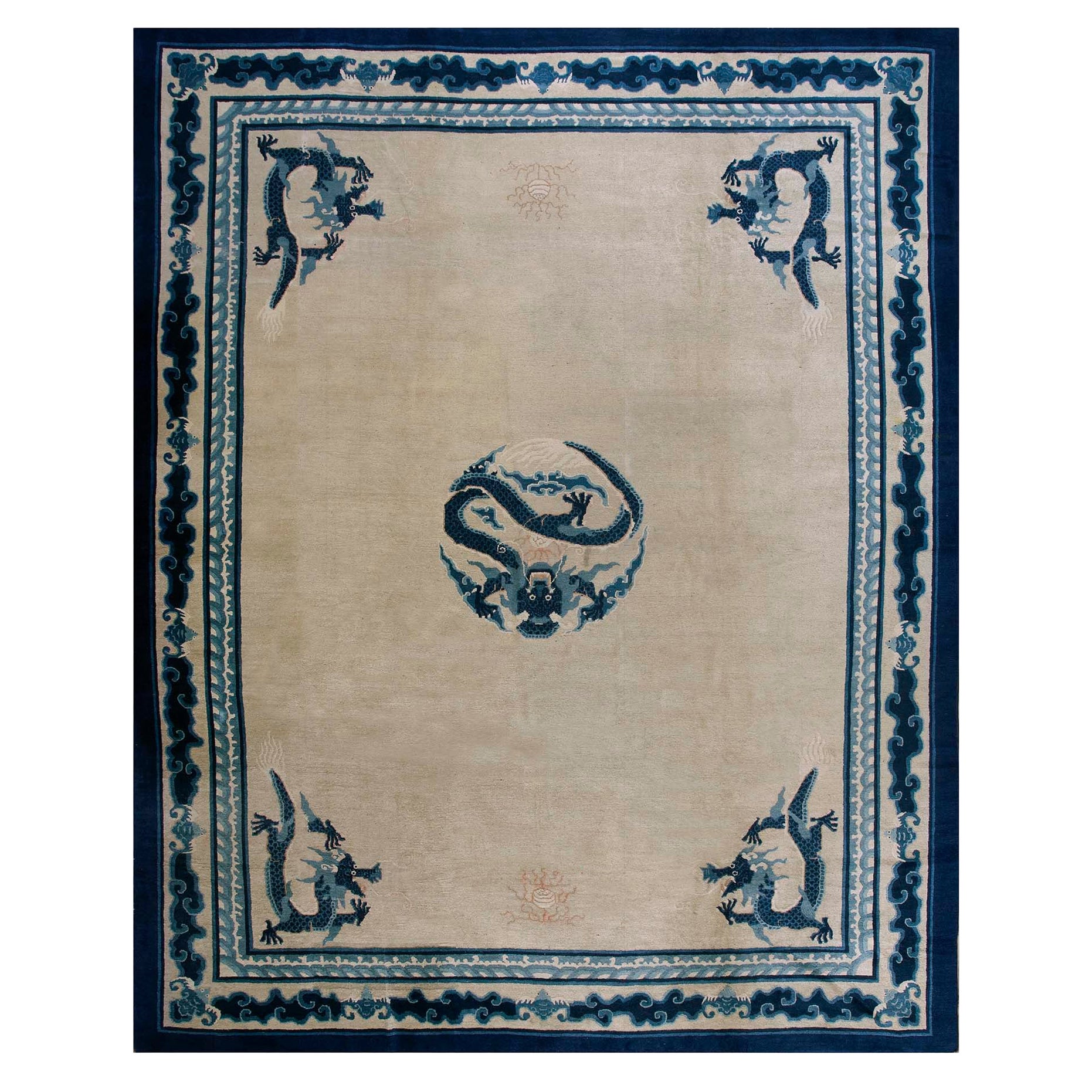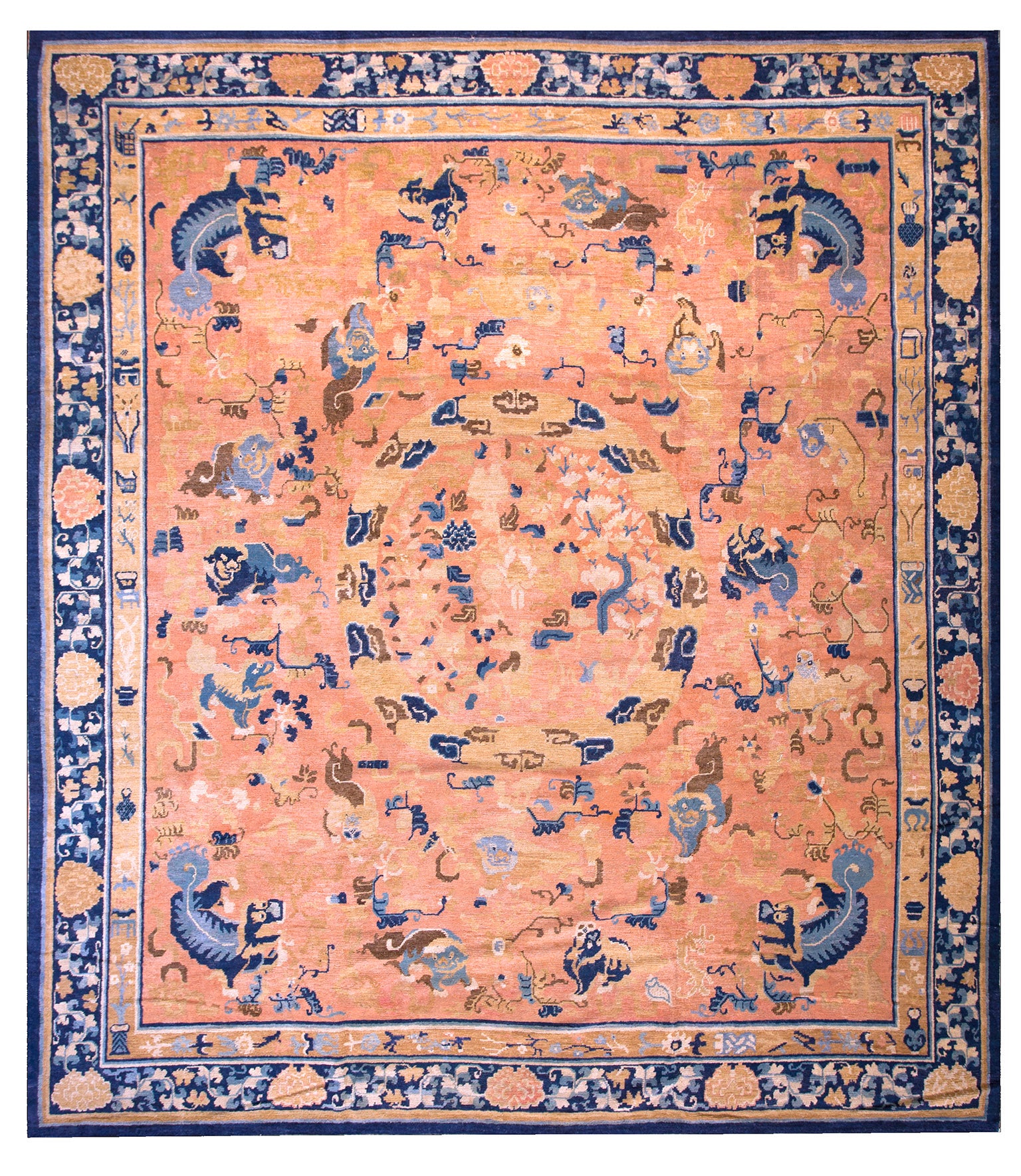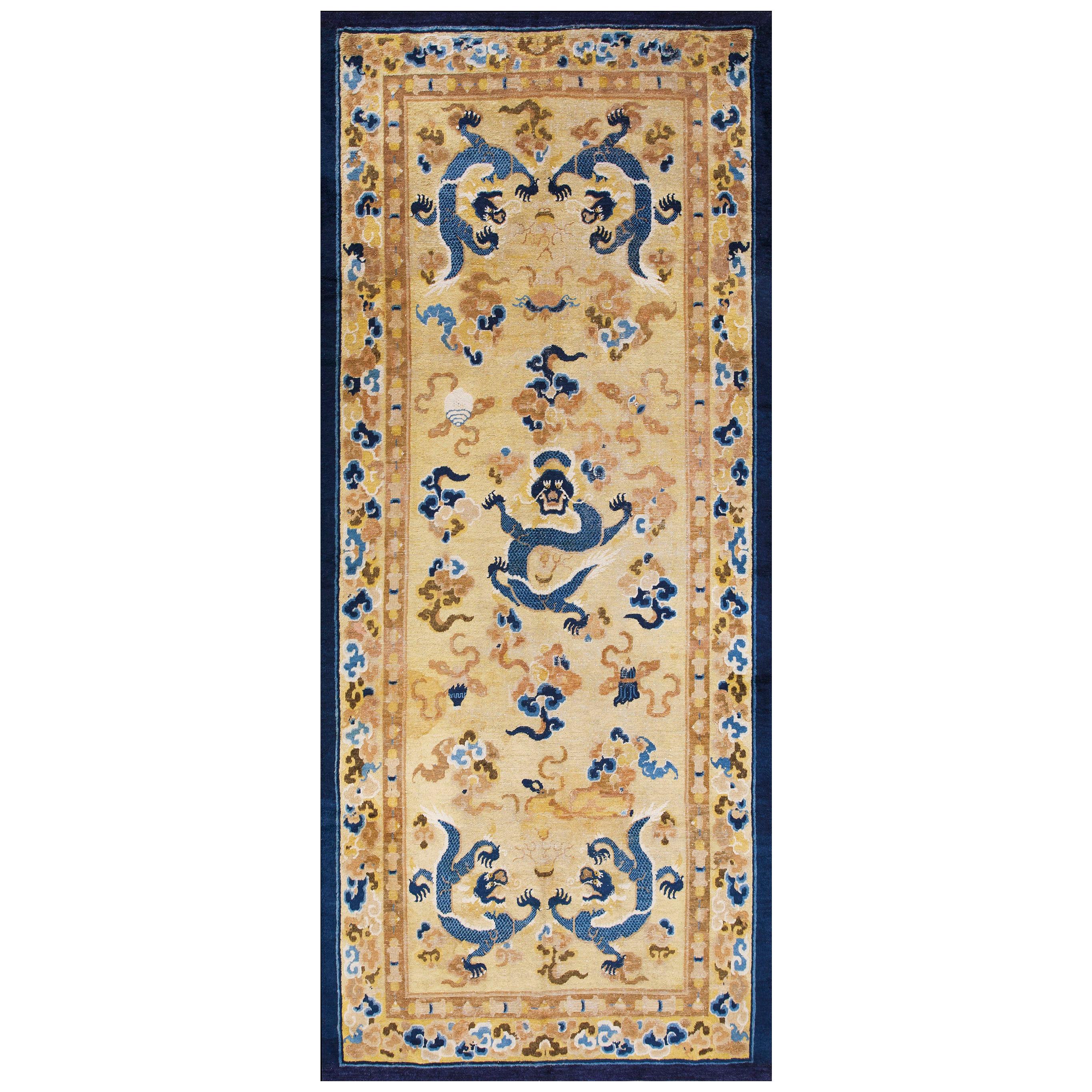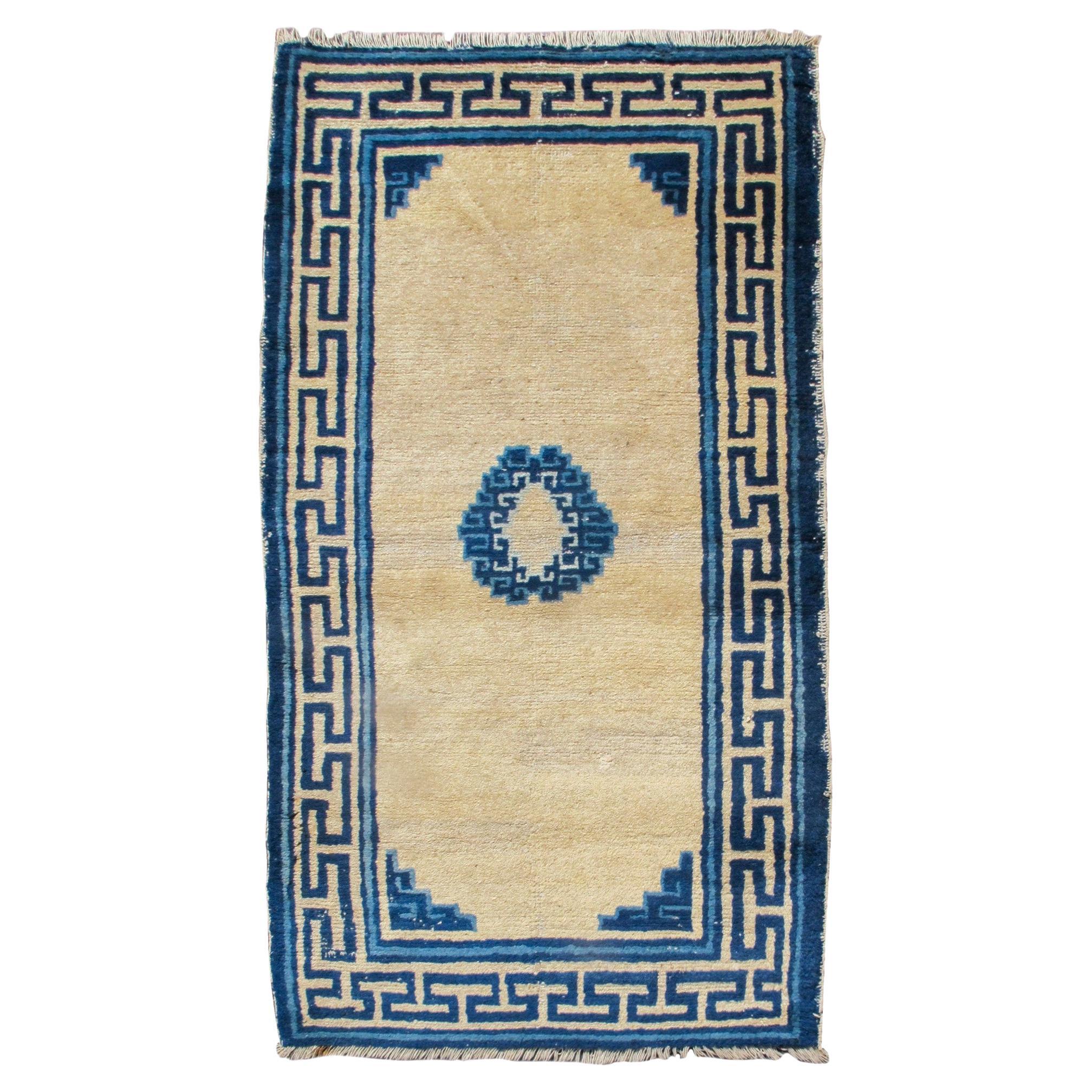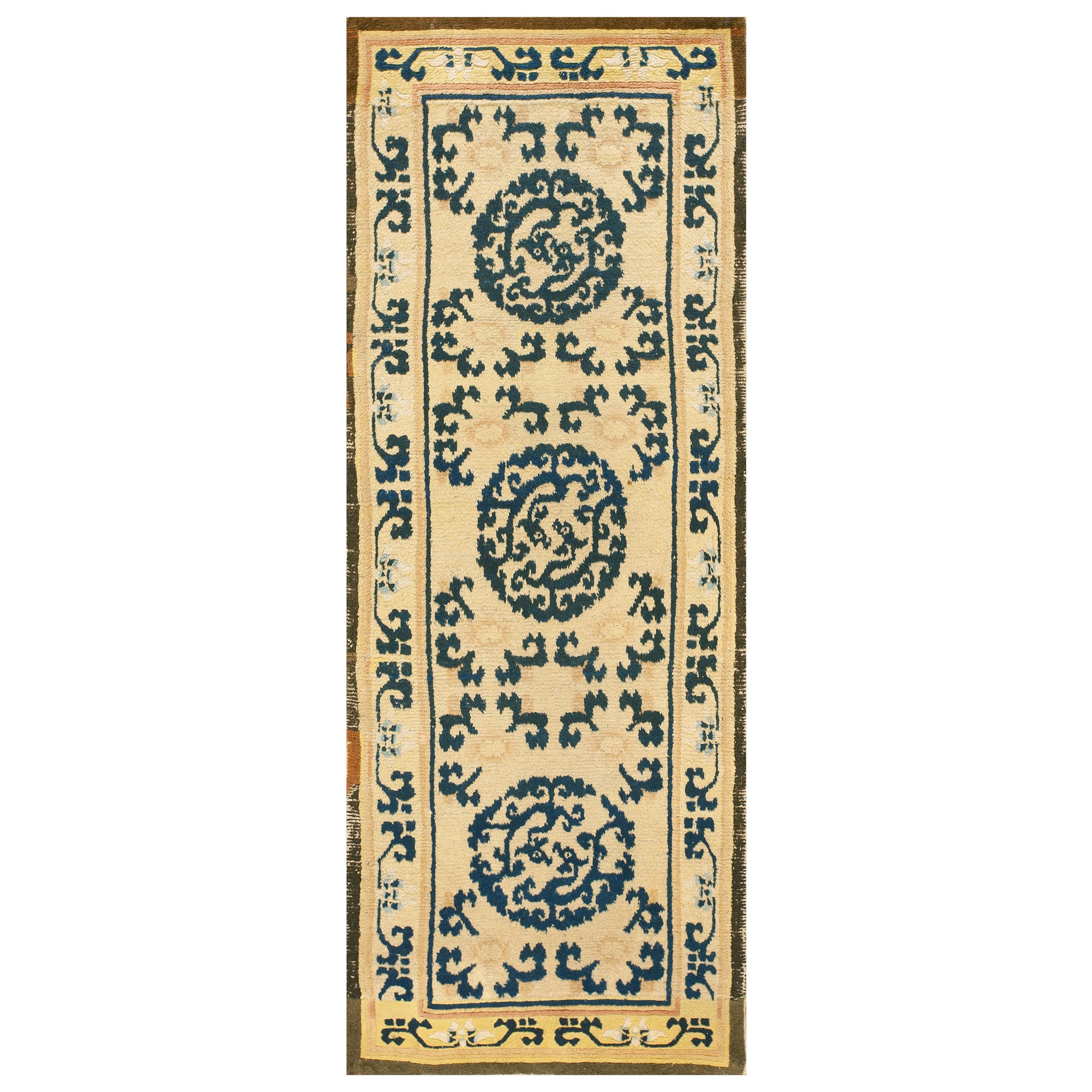Items Similar to 18th Century Chinese Ningxia Main Hall Carpet ( 12'8''x13'4''- 385 x 405 )
Want more images or videos?
Request additional images or videos from the seller
1 of 14
18th Century Chinese Ningxia Main Hall Carpet ( 12'8''x13'4''- 385 x 405 )
About the Item
Main Hall Carpet
Ningxia
North Central China
First Half of the 18th century
Measures: 12'8" x 13'4" - 386 x 406 cm
Structural Analysis
Warp: cotton, white, natural, Z-4-S, hand-spun, very irregular in both individual strands and overall
Weft: cotton, white, natural, Z-4-S, hand-spun, winder plied, thick and very soft, two shoots equally wavy, alternating, P.6 wool, Z-2.3.4-S
Knot: Pl/0°/horizontal 6 x vertical 5 = 30 per square inch
Sides: 2 cords each of 2 body warps, weft wrapped figure-8 style
Ends: n.o.
Wefts/Knots: 2 or 2+/1, thin knotting yarn, knot lines very irregular on verso
[n.b. check for T knots along edges]
Description and remarks
The corners of this now salmon (once red) ground square main hall carpet are marked by four, gigantic dark and middle blue lion dogs (over five feet long!). Two more dogs comprise a central roundel within a thick, polychrome cloud wreath. The rest of the field ornamentation consists of eight, large complete lotus palmettes, four additional fractional ones behind the corner dogs, and vigorous connecting vines and leaves, the latter primarily in dark blue. The two central dogs play with a brocade ball. There are, then, a total of six lion dogs.
[The dark blue main border…]
The four huge lion dogs are probably the largest on any surviving Ningxia carpet and are very finely detailed, with elements retained from much earlier prototypes. Each dog has a broad, leonine mane developing into an overpelt edged with split curls and a powder puff tail. There is a strong ivory backbone line from the neck to a volute in the tail. This line appears on the more dragon-like lion dogs in the well-preserved, magnificent Peking imperial late sixteenth-century carpet (7.85 m x 8.15 m), still in the Forbidden City [Carpets in the Collection of the Palace Museum, pp.XXX, ill.XXX]. The flaming joints on the latter dogs, a qilin feature, are also present in various later Ningxia carpet dogs, our 21376 among them, although here the front flames are reduced to small ivory veins or branches. In later rugs, or those with smaller dogs, the flames disappear entirely or are converted to limb contour outlines.
The dogs' faces and snouts are flat, but there are indications of teeth, even though the jaws are closed. The dogs are not barking nor do they hold in their mouths ribbons attached to brocade balls. There eyes are beady and lack eyelashes. They do not obviously protrude? as in certain other period examples [eg. Franses, pls.6,7,9]. While certain imperial dogs might be mistaken for dragons, these dogs are purely canine. Their ears are pointed and relatively short, and they lack the cloud-like involutions of the Beijing piece, cited above. Their manes are intended to be curly with scalloped outer edges, but lack internal detailing. Overall, the animals are fiercely playful, but not roly-poly pets. The dogs are grinning, not yapping.
The lion dogs of the central roundel are smaller and more schematic in design, partially because of the fading of the yellow to a buff-tan. Hence, details have been lost.
A published example with relatively larger corner dogs is the qilin and four dog rug [Franses, pl.6], 4.8 x 6.6, dated to the second half of the 17th century. The dogs here are more slender in body and each holds in its mouth ribbons connected to a brocade ball as in earlier imperial pieces. Their overpelts are far more simplified and schematic. The tails are very short with a distinct spiral. The selective fading has deprived us of many originally striking details in this small rug. Overall, the four corner dogs are proportionally smaller.
There are several idiosyncrasies in the large dogs of 21376. There is a dark blue and ivory speckled underside? to each dog and a similar area around the ivory tail volute. The feet of our dogs end in white puffs instead of detailed paws. The long, outstretched nearside back legs resemble those of [Franses, pl.6]. Our dogs have a dark blue hump in their lower backs. In some imperial pieces [eg. Franses, pp.24, 26-27], the hump is actually the top of the back offside leg and has flaming joint details. The effect has been converted into a convexity along the spine in 21376 instead of being off to one side. There are no flames issuing from the hidden joint.
The dark blue main border displays cartouches with various unrepeating antiques and precious objects: a fish, a square knot, scrolls, etc. Butterflies and small fruits* or paeonies with short, thin tendrils fill the interstices. The cartouches turn neatly at the corners. There is a "T" fret inner border with all four corners identically shaped, and a plain, dark blue outer band. The border is quite rare, appearing in smaller form on a daybed format rug, Sotheby's, New York, 7.4.99, lot 80, 5.5 x 8.3. Between the cartouches were stencil type lotuses with "M"-style tendrils.t. The rug was attributed, rather conservatively, to the mid-19th century. Given the close similarity of the borders, the rugs cannot have been made much apart chronologically and perhaps in the same workshop.
- Dimensions:Width: 152 in (386.08 cm)Length: 160 in (406.4 cm)
- Materials and Techniques:Wool,Hand-Knotted
- Place of Origin:
- Period:1720-1729
- Date of Manufacture:1725
- Condition:Repaired. Wear consistent with age and use.
- Seller Location:New York, NY
- Reference Number:
About the Seller
4.8
Platinum Seller
These expertly vetted sellers are 1stDibs' most experienced sellers and are rated highest by our customers.
Established in 1995
1stDibs seller since 2019
349 sales on 1stDibs
Typical response time: <1 hour
- ShippingRetrieving quote...Ships From: New York, NY
- Return PolicyA return for this item may be initiated within 3 days of delivery.
More From This SellerView All
- Late 19th Century Chinese Peking Dragon Carpet ( 10'2" x 12'8" - 310 x 385 )Located in New York, NYLate 19th Century Chinese Peking Dragon Carpet ( 10'2" x 12'8" - 310 x 385 )Category
Antique 1890s Chinese Chinese and East Asian Rugs
MaterialsWool
- 18th Century W. Chinese Ningxia Carpet ( 11'3" x 12'4" - 343 x 376 )Located in New York, NY18th Century W. Chinese Ningxia Carpet ( 11'3" x 12'4" - 343 x 376 )Category
Antique 1780s Chinese Chinese and East Asian Rugs
MaterialsWool
- Late 18th Century Chinese Ningxia Carpet ( 13'6" x 16'6" - 412 x 503 )Located in New York, NYLate 18th Century Chinese Ningxia Carpet ( 13'6" x 16'6" - 412 x 503 )Category
Antique 1790s Chinese Chinese and East Asian Rugs
MaterialsWool
- Late 18th Century Chinese Ningxia Kang Carpet ( 5'9" x 13'8" - 175 x 415 )Located in New York, NYLate 18th Century Chinese Ningxia Kang Carpet ( 5'9" x 13'8" - 175 x 415 ) Five dragons writhe and soar on a light yellow ground on this classically rendered long carpet from norther...Category
Antique Early 1800s Chinese Chinese and East Asian Rugs
MaterialsWool
- 18th Century Chinese Ningxia Carpet ( 2'9" x 7' - 85 x 215 cm )Located in New York, NY18th Century Chinese Ningxia Carpet ( 2'9" x 7' - 85 x 215 cm )Category
Antique 1770s Chinese Chinese and East Asian Rugs
MaterialsWool
- 18th Century Chinese Ningxia Carpet ( 7' x 10' 2''- 213 x 309 cm)Located in New York, NY3rd Quarter Of 18th Century Chinese Ningxia Carpet With Grain of Rice Pattern ( 7' x 10' 2'' - 213 x 309 cm)Category
Antique 1770s Chinese Qing Chinese and East Asian Rugs
MaterialsWool
You May Also Like
- Antique Chinese Ningxia Rug, 19th CenturyLocated in San Francisco, CAAntique Chinese Ningxia Rug, 19th Century Antique Chinese Ningxia rugs are rare and collectible. They are hand-woven and feature nature-inspired motifs such as flowers, birds, drago...Category
Antique 19th Century Chinese Chinese and East Asian Rugs
MaterialsWool
- Antique Chinese Ningxia Rug. Size: 6 ft 2 in x 12 ftLocated in New York, NYLate 17th Century Chinese Ningxia Rug, Country of Origin / Rug Type: China Rugs, Circa Date: Late 17th Century – Size: 6 ft 2 in x 12 ft (1.88 m x 3.66 m) Unlike many traditional Chinese rugs...Category
Antique Late 17th Century Chinese Chinese Export Chinese and East Asian ...
MaterialsWool
- Early 20th Century Handmade Chinese Ningxia Square Throw RugLocated in New York, NYAn antique Chinese Ningxia square throw rug handmade during the early 20th century. Measures: 2' 3" x 2' 4" The craft of the hand-knotted carpet in China, and the surrounding areas including Mongolia and Tibet, extends into the early centuries of the first millennium, C.E., but we really have a firm grasp only beginning in the later 16th century with large, very coarsely woven carpets, often depicting dragons, created for the Imperial Forbidden City palaces. Chinese carpets have always been commercial and there are no tribal groups responsible for any of the carpet weaving strains. When the Ming Dynasty fell in 1644, with no Imperial patrons, production moved to the city of Ningxia in north central China where several workshops turned out more finely woven pieces for the Mandarins of the administrative Ch’ing bureaucracy and well-to-do merchants. Ningxia was the major Chinese carpet center up through most of the 19th century, with first allover and then medallion designs on cotton foundations in medium weaves. Palettes were initially limited to yellows, dark blue and cream, but later widened to include reds, browns and even green. These antiques were the first Chinese carpets to be exported to the West and they fitted in well with the craze for Chinese blue-and-white porcelain in the second half of the 19th century. Ningxia also wove shaped and rectangular small rugs for saddle underlays, chair (“throne”) seats and shaped backs, pillar carpets with dragons or monks for Buddhist monasteries, and long divided runners for monastery meditation halls. These small rugs are among the most collectible of all Chinese weavings. Weavers from Ningxia set up workshops in the capital Peking (Beijing) in the 1860’s and began weaving Western room sizes for export, primarily to America. In blue – and – white and polychrome palettes, with round wreath medallions, precious objects, seasonal flowers, paeonies, lotuses, fretwork, clouds, butterflies and bats, all relatively spaciously drawn. The round “Shou” (Good Luck) character is also a prominent decorative motif. There are also a few Peking landscape pictorials with pagodas, houses, bridges, waterscapes and boats. Peking carpets were woven right up until WWII and production began again after the Cultural Revolution around 1970. They are moderately well-woven, on cotton foundations, exactingly executed and indisputably Chinese. Many are in the blue-and-white style. Nothing else looks like a Peking carpet and for a Chinese “look” in a room, they are absolutely indispensable. Sizes range from scatters and a few runners, through the popular 9’12’ size, to large carpets over 20’ which must have been special orders. The earliest Peking Revival carpets are pliable and fairly thin, but they became heavier and more compact in the 20th century, in competition with Art Deco carpets from Tientsin. The modern, post- 1970, pieces are in the traditional Peking style, but are a little too regular and neat. Exactitude has been favored over character, as hard to explain that as it is. There are a number of all-silk and silk-and –metal thread pieces, many with inscriptions purporting to link them with rooms in the Imperial palaces, bringing very substantial auction prices, but none are really antique. The genre emerged after WWI and the present demand comes from mainland Chinese. The silk piles often stand in pattern relief against flat woven gold metal thread grounds. The inscriptions are apocryphal, the rugs are flashily opulent, perfect for nouveaux riches. The Art Deco period between the two World Wars saw a distinctive carpet industry developing in Tientsin (Tianjin) in northeastern China. These are highly prized for their transitional design character, neither overtly Chinese, nor abstractly modern/contemporary. Woven exclusively for export, usually by and for American firms, such as Nichols and Elbrook, they are totally in the “Jazz Age Modern” style of the 1920’s, often without borders, with abstract or abstracted patterns, and only with, at best, a few Chinese-y pattern elements. Vases asymmetrically placed in the corners are features of some of the more Chinese-y carpets. Open fields with floral sprays and branches growing in from the edges are anther design innovation. Often, Chinese motives have been re-imagined in more sharp-edged, abstract manners. Some have no references whatsoever to natural elements. The patterns are sharp and the rugs are never subdued, soft or restrained. The rugs are heavily constructed, with crisp, unfading dyes and medium to medium coarse weaves on cotton foundations. All are extremely well-executed, with none of the vagaries, variations or twists found on even high-quality Persian rugs. The majority are in the 9’ by 12’ format and a surprising number can be found in top condition. There also was a substantial production in Peking from, especially from the Fette factory. Elliptical and round carpets, and lighter, often pastel colors, were a specialty. Nothing looks like an Art Deco Chinese and they work well with traditional Chinese furniture and the most modern decor as well. These is no substitute for a good Chinese Art Deco carpet. Chinese carpets also include small scatters from Tibet, with high quality wool, floating dragons and allover textile patterns. The colors of vintage and modern pieces are bright, but there are antique small rugs...Category
Early 20th Century Chinese Art Deco Chinese and East Asian Rugs
MaterialsWool
- Chinese Imperial Foo Dog, 18th CenturyLocated in Ferrara, ITThis ancient Chinese carpet knotted in the Ningxia area in the 18th century measures 290 × 196 cm (9' 6" × 6' 5"). From traditional Chinese iconography the decoration takes flower in...Category
Antique 18th Century Chinese Other Chinese and East Asian Rugs
MaterialsWool
- Chinese Ningxia Rug 1880-1900Located in Ferrara, ITIt is a small Ningxia carpet from the homonymous area in northern China, handmade between 1880 and 1900, measuring 133 × 71 cm (4' 4" × 2' 3") and it is knotted in wool on warp and w...Category
Antique Late 19th Century Chinese Other Chinese and East Asian Rugs
MaterialsWool
- Antique Chinese Ningxia Bench RunnerLocated in Dallas, TX78455 Antique Chinese Ningxia Bench runner Meditation Mat, 02'01 x 13'01. Emanating mythical elements with incredible detail and texture, this hand knotted wool antique Chinese Ningx...Category
Early 20th Century Chinese Chinese Chippendale Chinese and East Asian Rugs
MaterialsWool
Recently Viewed
View AllMore Ways To Browse
Main Bar
New Chinese Design
Main Carpet
Chinese Display
China Display
Chinese S
Main Line
Joint Detail
Chinese 19th Blue
Antique China Display
Middle East Furniture
Very Rare China
Yellow And Blue Chinese
Chinese Blue Pieces
Chinese Type Furniture
Chinese Style White Furniture
Very Rare Chinese
19th Century Chinese Dragon
